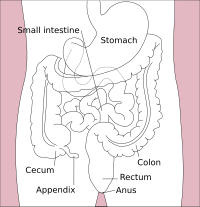
Photo from wikipedia
Background Synbiotics often are prescribed to limit antibiotic‐associated gastrointestinal signs (AAGS) in cats, but data to support this recommendation are lacking. Objective To determine whether synbiotic co‐administration mitigates AAGS in… Click to show full abstract
Background Synbiotics often are prescribed to limit antibiotic‐associated gastrointestinal signs (AAGS) in cats, but data to support this recommendation are lacking. Objective To determine whether synbiotic co‐administration mitigates AAGS in healthy research cats treated with clindamycin. Animals 16 healthy research cats. Methods A randomized, double‐blinded, placebo‐controlled, 2‐way, 2‐period, crossover study with a 6‐week washout was performed. Each study period consisted of a 1‐week baseline and a 3‐week treatment period. Cats received 75 mg clindamycin with food once daily for 3 weeks, followed 1 hour later by either 2 capsules of a synbiotic or placebo. Food consumption, vomiting, fecal score, and completion of treatment were compared using repeated measures split plot or crossover designs with covariates, with P < 0.05 considered significant. Results Cats that received the synbiotic were more likely to complete treatment in period 1 (100% vs. 50%, P = 0.04). Cats vomited less when receiving the synbiotic but this was not significant, but there were significant period effects (F‐value = 11.4, P < 0.01). Cats had higher food intake while receiving the synbiotic (F‐value = 31.1, P < 0.01) despite period effects (F‐value = 8.6, P < 0.01). There was no significant effect of treatment on fecal scores, which significantly increased over time (F‐value = 17.9, P < 0.01). Conclusions and Clinical Importance Administration of a synbiotic 1 hour after clindamycin administration decreased hyporexia and vomiting in healthy cats. Additionally, significant period effects suggest that clinical benefits of synbiotic administration persist for at least 6 weeks after discontinuation, decreasing the severity of AAGS in cats that subsequently received clindamycin with placebo. Unlike in people, synbiotic administration did not decrease antibiotic‐associated diarrhea.
Journal Title: Journal of Veterinary Internal Medicine
Year Published: 2017
Link to full text (if available)
Share on Social Media: Sign Up to like & get
recommendations!